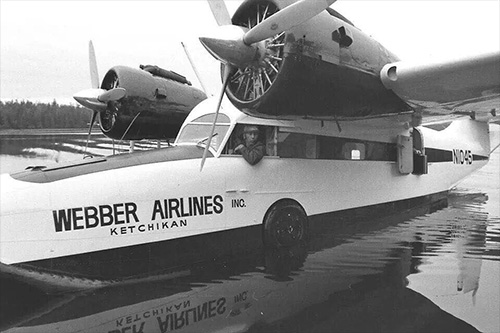The Goose was everyone's favorite 'bird'Grumman amphibian defined SE air travel for 30 yearsBy DAVE KIFFER June 13, 2021
The Goose was an amphibian, a plane that could take off from a concrete runway and later land in the water or vise-versa. It could also land in the water and then use its wheels to go up onto the larger beaches. Unlike smaller floatplanes it had significant cargo space, could carry 10 passengers and - with its twin 450 horsepower Pratt and Whitney engines - travel between most of the larger Southeast communities in an hour or less. Unlike float planes which have pontoons, an amphibian is essentially a flying boat that lands on its hull in the water. That fact sometimes comes as a shock to passengers who are not expecting to see the water splash up over the windows during landing.
Even after land airports were built in the region following World War II, the Goose continued to help connect the smaller communities and logging and fishing camps with the larger towns. They were also crucial to ferrying passengers from the Ketchikan area airport on Annette Island and Ketchikan proper on Revillagigedo Island. Most of the people who lived in Southeast in the 1950s and 1960s were used to flying on the Goose as it was usually the only way to get around, especially to Annette or places like Prince of Wales Island. The Grumman Goose was originally designed in the mid 1930s as a commuter aircraft to carry passengers between the communities on eastern Long Island and New York City. A group of wealthy residents basically commissioned Grumman to develop the plane, also envisioning it as a "flying yacht" or as corporate transportation. The first Goose was completed in 1937 and very quickly caught the eye of the military that was looking for a small amphibious aircraft as well. During World War II, more than 300 Goose were built for the amry and navy and used for a variety of search and rescue and surveillance missions as well as transportation. It was during the War that local pilots such as Bob Ellis and Bud Bodding became familiar with the Goose and saw that it would translate well in Southeast Alaska. After the war, Ellis brought the first one to Ketchikan in November of 1945. Ellis Airlines would acquire and operate nine Goose, making them the mainstay of its dominant regional service. Shell Simmon's Juneau-based airline, Alaska Coastal, would also use a similar number of the Goose. When the two companies merged in 1962, the combined Alaska Coastal Ellis would eventually have 20 Grummans. Ellis told the Ketchikan Daily News in 1986 that it sometimes took up to eight different Grummans to ferry all the passengers from Annette to Ketchikan when one of the larger jets came in. "The Goose is an airplane you can be affectionate about," Ellis said in 1986. "It is a very forgiving aircraft. A pilot can make minor mistakes and the plane doesn't mind." He noted that the plane could be "trimmed" and flown hands off. "You could sit there and read a book," he noted, adding that he did not recommend doing that. Anyone living near the waterfront in the Newtown Area of Ketchikan where the Ellis terminal and maintenance buildings were located became used to the day-long roar of the Goose taking off. They were so loud that people on phone calls would have to pause and wait until the planes had passed before continuing their conversations. Gerald "Bud" Bodding flew the Goose from 1942 until his retirement from Alaska Airlines in 1974, putting in 18,000 hours in the plane, more than anyone else in Alaska, probably in the world. It earned him the nickname "Father Goose". He first encountered the Goose while serving as a Navy pilot in Kodiak. Although he eventually moved up to flying admirals around in large twin engine DC- 4, he was happy to return to the Goose when he went back to work for Ellis Air after the War.
"It was a no drama plane," he told the Ketchikan Daily News in 1982. "It never threw you any kind of surprise. And it got you out of even the worst kind of weather." Herman Ludwigsen, a 50-year bush pilot in Southeast and Southwest Alaska, flew nearly every type of small plane in Alaska, but his favorite plane was a Grumman Goose that he flew for Webber Air that he called "045. “We just fit,” he said in an interview in 2020. “It just knew what I wanted to do and it did it. It did its work very well.”? Ludwigsen said that pilots often compare Cessna 185s to sports cars and Dehavilland Beaver's to buses, but that flying a Goose was like driving a train once its twin engines got up to speed. “Once you got it going, it just went straight,” he said. “It carried a tremendous load. As big as it is, it looks clumsy, but you can do whatever you want with it.” He said the Goose was also strong enough to handle the thrashing that the weather gave planes in Southeast, more so than the Cessna's and the Beavers. Unfortunately, "045" was involved in one of the worst days in southern Southeast Alaska aviation history, August 25, 1978. The Webber Goose, flying from northern Prince of Wales Island to Ketchikan, crashed into the waters of Sumner Strait killing the pilot - and owner of Webber Air - Jack Swaim and all 11 passengers. At the time, it was the worst crash involving a Goose. One of the last people to see the ill-fated Webber Flight before the crash was 16-year-old John Pringle who lived in Labouchere Bay and attended the school there. His father worked for a road building company in the area. One of Pringle's jobs was to help load and unload planes when they flew into the community. His teacher, Mrs. Gaedecke, had given him permission to meet the planes when they arrived during school hours. He helped the pilot, Jack Swain, load more luggage onto the plane. "As Jack and I finished I sensed he was a little tense and in a hurry," Pringle said in 2019. He said that three passengers, including his teacher Mrs, Gaedecke, had yet to arrive for the flight. "Jack, would you like me to go find them and have them hurry up? 'Yes,' he said, shaking his head and giving me a thankful smile." Pringle also said he made eye contact with the several of the passengers on the plane. As he started to go look for the missing passengers, a van arrived and they boarded the plane. He heard the Goose take off. Later, when another Webber plane landed, he found out the Goose was missing. "This event was one of the most impactful of my life," Pringle said in 2019, adding that he was inspired by Mrs. Gaedeke to become a teacher. Within a decade, the Goose were no longer on runs in Southeast, having been replaced by single engine airplanes that were cheaper to operate. The last commercial Goose flight was by Ketchikan based Westflight Air in 1987. Chuck Slagle, the owner of Westflight, told the Ketchikan Daily News on Aug. 3, 1987 that it no longer made sense to operate the Goose commercially in Ketchikan and he was taking it south to Seattle to be sold. That particular Goose had been in flying in Southeast, originally for Alaska Coastal, since the late 1940s and had been converted to a Super Goose, one with turbine engines and retratractable wing floats. But before it was purchased by Westfilight in 1981, it was converted back to the traditional radial engines. Slagle said the Goose still had a larger payload than the float planes but that it didn't make sense to have a single Goose in his fleet because it was impractical from a maintenance standpoint. After that Goose left Ketchikan, there was still a single Goose operating out of Petersburg for several years. The Alaska Department of Fish and Game also continued to operate a Goose for more than a decade into the 1990s. Pen Air in the Aleutians also continued to occasionally use a Grumman Goose until 2012. Since then the only Goose sightings are the handful of ones in private hands that occasionally pass there. Whenever one stops at the Ketchikan airport, it always draws a crowd. The fondness for the Goose remains. Since 1989, a group of local aviation enthusiasts sponsored by the Tongass Historical Society has been working to renovate the first Goose that arrived in Ketchikan in 1945 and served Ellis Airlines for many years. Reconstruction work on N88821 continues to this day at a warehouse on North Tongass Highway, although a final display place has yet to determined.
On the Web:
Contact Dave at dave@sitnews.us Dave Kiffer ©2021 Publication fee required. © Representations of fact and opinions in comments posted are solely those of the individual posters and do not represent the opinions of Sitnews.
|
||||||




